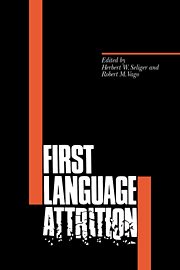Book contents
- Frontmatter
- Contents
- List of figures
- List of tables
- List of contributors
- Acknowledgment
- Part I Survey studies
- Part II Group studies
- 6 L1 loss in an L2 environment: Dutch immigrants in France
- 7 The sociolinguistic and patholinguistic attrition of Breton phonology, morphology, and morphonology
- 8 Language attrition in Boumaa Fijian and Dyirbal
- 9 Pennsylvania German: convergence and change as strategies of discourse
- 10 Lexical retrieval difficulties in adult language attrition
- 11 Spanish language attrition in a contact situation with English
- Part III Case studies
- Index
11 - Spanish language attrition in a contact situation with English
Published online by Cambridge University Press: 14 January 2010
- Frontmatter
- Contents
- List of figures
- List of tables
- List of contributors
- Acknowledgment
- Part I Survey studies
- Part II Group studies
- 6 L1 loss in an L2 environment: Dutch immigrants in France
- 7 The sociolinguistic and patholinguistic attrition of Breton phonology, morphology, and morphonology
- 8 Language attrition in Boumaa Fijian and Dyirbal
- 9 Pennsylvania German: convergence and change as strategies of discourse
- 10 Lexical retrieval difficulties in adult language attrition
- 11 Spanish language attrition in a contact situation with English
- Part III Case studies
- Index
Summary
Introduction
This chapter examines processes of simplification and loss of tense–mood–aspect morphology in the Spanish spoken by adult Spanish–English bilinguals living in the eastern section of Los Angeles, California. It is part of a larger project which investigates the speech of fifty Mexican–American bilinguals who represent three different immigrant groups according to length of stay in the US. A subset sample of fourteen speakers is included in the study of verbal morphology: six speakers from group 1, and four each from groups 2 and 3.
Group 1 includes only speakers born in Mexico who immigrated to the US after the age of eleven. Group 2 encompasses speakers either born in Los Angeles or who have immigrated from Mexico before the age of six. Group 3 also comprises speakers born in Los Angeles; in addition, at least one parent must respond to the definition of those in group 2.
The complexity of this community accounts for the existence of what I call a bilingual continuum, similar to a Creole continuum in that one may identify a series of lects ranging from full-fledged to emblematic Spanish and, vice versa, from full-fledged to emblematic English depending on whether the bilingual is more or less dominant in Spanish or English. Even further, these individual lects do not correspond to fixed dichotomies of the type “compound-coordinate”, or “balanced-unbalanced”. Rather, at the individual level they represent a wide range of dynamic levels of proficiency in the subordinate language, i.e. it is in principle possible for an individual to move or be moving toward one or the other end of the continuum at any given synchronic stage of his life.
- Type
- Chapter
- Information
- First Language Attrition , pp. 151 - 172Publisher: Cambridge University PressPrint publication year: 1991
- 47
- Cited by



